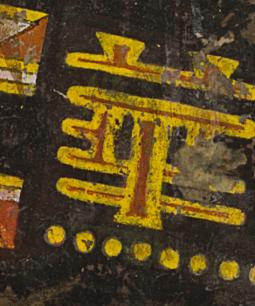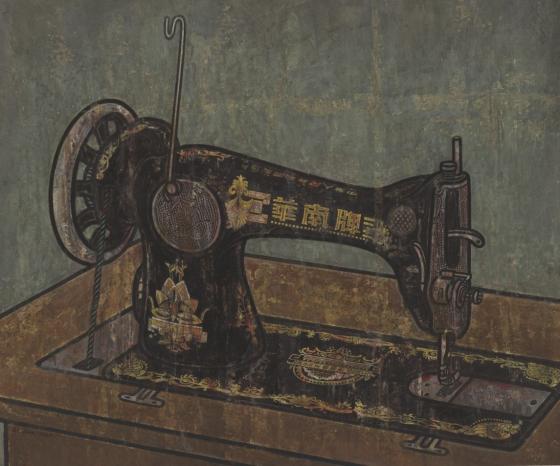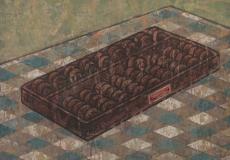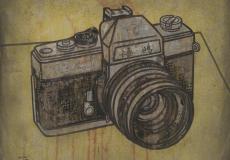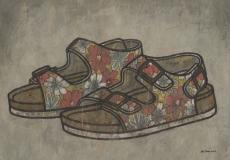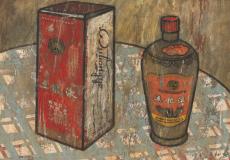Artist He Jian is notable for his amalgamation of ancient and contemporary Chinese culture. Rather than painting in oil like most of his contemporaries, he uses rice paper, dry pigment, and binder as his media. He strategically layers and manipulates his paints to assume the timeworn quality of the 14th century Yuan Dynasty frescoes at the Yong Le Temple in Shanxi Province. He Jian uses this distinctive new-old, antiquated style to present a wide range of quotidian subject matter. Although many of his works portray figural groups engaged in activities characteristic of contemporary Chinese life, in this series He Jian directs his focus towards some utilitarian objects that signal China’s shift towards a consumer culture. In this painting,
Although potentially unremarkable to Western viewers, the sewing machine has a larger cultural significance in China: during the 70s and 80s, the sewing machine was one of the “three essentials” necessary for a prosperous marriage, and its grade a direct indicator of wealth and status. The goods that comprise the “essentials” have been continually redefined, and thus serve as an indicator of China’s economic development since the mid-20th century. For example, whereas in the 1980s these items were a watch, a bike, and a sewing machine, today they are more likely to include a house, a car, and money for vacation travels. For He Jian and his generation, sewing machines of this sort are familiar household objects from their childhood. His presentation in the style of ancient Chinese frescoes historicizes and romanticizes the sewing machine, and suggests its elevation to the same level as the Taoist deities that line the walls of Yong Le Temple. He Jian's painting melds the style and flavor of ancient China with a subject that heralds its recent history, visualizing the complex dialogue between ancient and contemporary Chinese culture.
A word from The Artist
For a long time I’ve been pondering the tools and materials of traditional Chinese painting, the limits and problems of its expressive abilities, and its possibilities in a contemporary context. Specifically, I try to use the mottled texture of the ancient frescoes and the independent quality of their lines to create an image that tends towards realism. My images usually attempt to capture the complex feelings caused by unprecedented cultural jumble encountered by people in today's world, as well as the indescribable aching associated with memories and the passing of time.
Sewing Machine
缝纫机
By HE Jian
由何剑创作
Prints are created with archival-quality pigment inks and 100% cotton rag acid-free paper.
Each print comes with a certificate of authenticity numbered and signed by the artist.
Dimensions are for the size of the paper on which the image is printed - not the image itself. All prints have a white border to allow for framing.
Revenues from each purchase are shared with the artist.
He Jian strategically layers and manipulates his paints to take on the timeworn quality of 14th century Yuan Dynasty frescoes.
